
|
|

September 28, 2007
Rochester's AM 680/990 (WNYR/WLGZ/etc.)
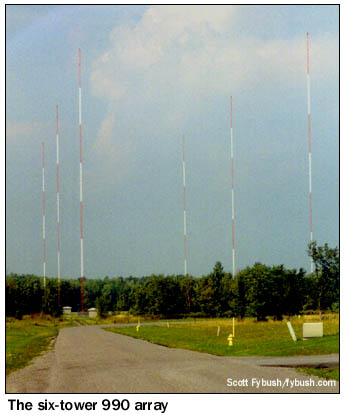 Welcome
back to another exciting season of Tower Site of the Week - and
thanks for your patience during our busy summer travel schedule!
We have one more trip still upcoming (North Carolina and Virginia,
around the NAB Radio Show at the end of September), but we're
excited about all the great tours we'll be sharing with you in
the months to come. We'll take you to some big AM signals (WBBM,
WSCR, KSL), some unusual arrays (how about an AM directional
array with I-90 running right through the middle?), some prominent
FM/TV mountaintops (Boise's Deer Point, Las Vegas' Mount Arden),
not to mention the fields of Iowa, the FMs of Utica, and many
more.
Welcome
back to another exciting season of Tower Site of the Week - and
thanks for your patience during our busy summer travel schedule!
We have one more trip still upcoming (North Carolina and Virginia,
around the NAB Radio Show at the end of September), but we're
excited about all the great tours we'll be sharing with you in
the months to come. We'll take you to some big AM signals (WBBM,
WSCR, KSL), some unusual arrays (how about an AM directional
array with I-90 running right through the middle?), some prominent
FM/TV mountaintops (Boise's Deer Point, Las Vegas' Mount Arden),
not to mention the fields of Iowa, the FMs of Utica, and many
more.
This week, though, we continue our look at some sites that are much closer to home - this week, at the biggest AM directional array in upstate New York.
The six-tower array of WLGZ (990 Rochester) on West Ridge Road (NY 104) in the town of Clarkson, 14 miles west of Rochester, is also one of the newest in the region, dating back only to the early eighties. But the history of the underlying station goes back almost forty years earlier, with so many twists and turns that almost nobody (including the station's current owners) has the full story.
Sounds like prime Tower Site of the Week fodder, doesn't it?
The station that's now WLGZ is, in fact, the direct descendant of the first of the three new AM signals that came on the air in Rochester just after World War II. WRNY (680) signed on February 2, 1947 as a 250-watt daytimer, beating WARC (950) and WVET (1280) to the airwaves in part because its setup was so simple - a short non-directional tower on Colfax Street, at the eastern edge of the city of Rochester.
Owner Monroe Broadcasting built fairly lavish studios at 191 East Avenue, on the edge of downtown Rochester, with studio space designed for eventual expansion into television. While waiting for TV to arrive, WRNY put Rochester's third FM signal on the air, in part to overcome its daytime-only handicap in a city that had five full-timers on the air by the end of 1947. WRNY-FM, initially on 97.7, would migrate to 97.9 before giving up the ghost in the mid-fifties.
Monroe secured a TV construction permit in 1953, but for a UHF signal on channel 27, rather than the desired channel 10, which became a shared-time signal operated by two of Monroe's competitors, WHEC (1460) and WVET. With no useful TV outlet, WRNY radio itself barely made it to its tenth anniversary. Today it's remembered, if at all, by a fading sign painted on the side of a downtown office building proclaiming "MUSIC NEWS SPORTS" - and by that 191 East Avenue address, since WRNY sold the building to WHEC radio and television after its TV plans failed to materialize. (The original WRNY building was torn down in 1979, when the current WHEC-TV building went up next door; the site is now WHEC's parking lot.)
On July 27, 1957, WRNY became WRVM, the first top 40 station in the market, and for at least a little while the station found some success with the format. (At least one of the WRVM jocks, a young Johnny Holliday, would later go on to greatness in much bigger markets, becoming a prominent voice for ABC sports; to this day, he's still looking for airchecks of his early days on WRVM.)
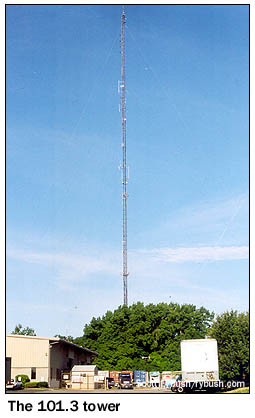 WRVM,
with studios at 130 S. Clinton Avenue, also applied for an FM
and was granted a CP on 100.5. WRVM-FM never went on the air,
but the frequency was transferred to another new CP, WVOR (92.5)
in 1963, allowing WVOR to come on the air without interfering
with off-air pickups from its sister station WBUF (92.9) in Buffalo.
WRVM,
with studios at 130 S. Clinton Avenue, also applied for an FM
and was granted a CP on 100.5. WRVM-FM never went on the air,
but the frequency was transferred to another new CP, WVOR (92.5)
in 1963, allowing WVOR to come on the air without interfering
with off-air pickups from its sister station WBUF (92.9) in Buffalo.
Once again, the handicap of being a daytimer made WRVM vulnerable to competition, and when full-timer WBBF (950) went top 40, WRVM's days were numbered. In 1965, WRVM became WNYR, the city's first country station, and under owner Malrite it would enjoy two decades of success all alone in the format. FM entered the picture again in 1966, when WNYR-FM (101.3) signed on. (The license came from WBBF, which wanted to escape onerous public-interest obligations it had agreed to when it put WBBF-FM on the air as a listener-supported classical station in 1961; after 101.3 went to Malrite, WBBF would put a more commercial classical format on the air as WBFB on 92.5.)
As the sixties became the seventies, Malrite wasn't the only station owner troubled by the 680 daytime signal. Up in Canada, Ted Rogers had put CHFI (later CFTR) on the air at 680 in the late sixties, using a 13-tower array in Mississauga to protect the other stations on the channel - including WNYR, whose signal would skip across Lake Ontario and wreak havoc with CFTR reception east of Toronto. Rogers had the resources to fix that problem, not to mention the political connections, and he pulled off a rare feat in the late seventies, winning international permission to move WNYR from 680 to fulltime operation on a Canadian clear channel, 990. Rogers paid for the move, which took several years to complete.
In July 1980, WNYR changed frequency, operating by day on 680 and at night on 990 for several days before finally leaving 680 for good. Its initial 990 facility was a temporary one - a three-tower array built at the Colfax Street site that by then held the original 680 tower and a much taller stick erected in the mid-seventies for the former WNYR-FM, by then WEZO on 101.3. With 1000 watts by day and 250 watts at night, the temporary site left WNYR with only a pipsqueak night signal, but by then construction was underway on 990's permanent site out to the west. (No traces of the temporary site can be seen today, and the old 680 tower came down in the nineties as well. We'll spend some time on the 101.3 tower, which still stands, in a future Site of the Week.)
The six 280-foot towers were completed in 1983, and WNYR went to full-power operation not long afterward. Its 5000-watt, four-tower daytime signal goes east and west from Clarkson, making it one of the stronger Rochester signals in the Buffalo area. At night, 990's 2500 watts use all six towers to pump the signal east over downtown Rochester, in a narrow lobe that hits much of New England better than it reaches the southern reaches of Monroe County. Still, it was a full-time signal (and at someone else's expense), which bought WNYR a few more good years before FM found country in Rochester.
Perhaps the heyday of WNYR came in the early eighties, when it could be found at 360 East Avenue in a facility shared with Malrite sister stations WEZO and WUHF (Channel 31), a new independent signal that had signed on in 1981.
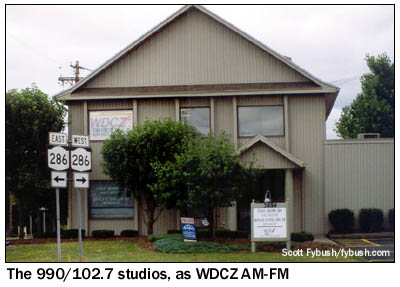 One
attempt at a country FM (WZKC 98.9) failed in 1986 after just
a year on the air, but the second attempt, WBEE 92.5, was an
immediate success when it signed on in 1987. That summer, 990
said farewell to "Fresh Country Air," taking a standards
format.
One
attempt at a country FM (WZKC 98.9) failed in 1986 after just
a year on the air, but the second attempt, WBEE 92.5, was an
immediate success when it signed on in 1987. That summer, 990
said farewell to "Fresh Country Air," taking a standards
format.
The WNYR calls went away in 1988, replaced by the WEZO calls that had been on its sister FM station, now "Warm" WRMM. The next decade brought a merry-go-round of formats and calls, including WRMM (1990, in a simulcast with WRMM-FM, then as the flagship for the Rochester-based Northeast Satellite Network AC service) and WCMF (1993, as a simulcast with WCMF-FM 96.5 and as a sports station, including several seasons in which it was the flagship for the Rochester Red Wings, a move much appreciated by your editor, who was then living in Boston, where that 990 signal was a strong one after dark.)
In 1997, then-owner American Radio Systems attempted to donate the AM station to St. John Fisher College in order to remain under the ownership cap as it added WPXY-FM 97.9 to the group, but before that sale could be consummated another buyer stepped forward: religious operator Crawford Broadcasting.
Crawford bought 990 in August 1997, moving the station from ARS' suburban studios at 3136 S. Winton Road in Henrietta to the studios of its WDCZ-FM (102.7 Webster) at 2494 Browncroft Boulevard and renaming it WDCZ(AM), simulcasting the FM signal.
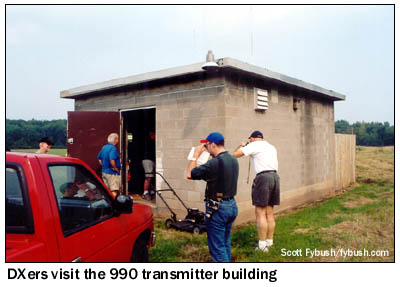 |
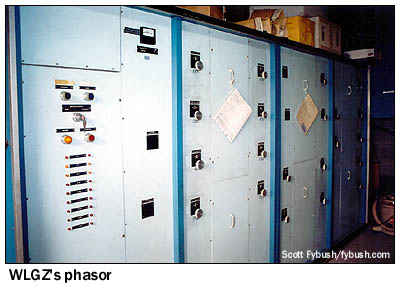 |
One final format change brought 990 to its current form: in December 1999, Crawford flipped it from WDCZ to WLGZ, "Legends 990," with a standards format and local jocks in morning and afternoon drive. In 2005, WLGZ became an early adopter of HD Radio, and for a time its programming was also heard on the HD2 channel of the 102.7 FM signal. (Which, by the way, comes from the 101.3 tower on Colfax Street, bringing that connection full circle.)
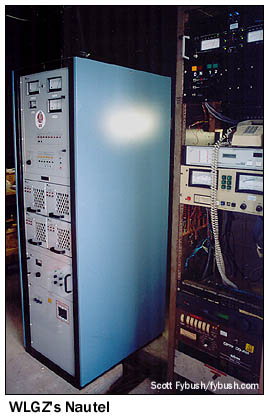
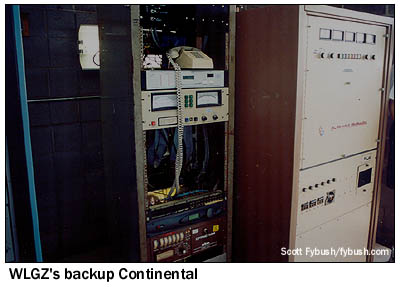 For all that history,
the 990 site in a clearing just north of Ridge Road is really
a pretty simple and unassuming one.
For all that history,
the 990 site in a clearing just north of Ridge Road is really
a pretty simple and unassuming one.
We visited during the 2004 National Radio Club convention in western New York, and the visitors had to move in and out of the small concrete-block transmitter building in shifts.
To one side of the building is the phasor, with the daytime signal on the left and the nighttime signal on the right side. Across the aisle are two transmitters, a Nautel Ampfet as the main and a Continental 315 (the original 990 rig from the eighties, I believe) as the backup.
At the time, WLGZ was still running AM stereo; we'll have to go back soon and get some updated pictures with the digital equipment installed. (Nighttime HD operation here has yet to get underway as we write this; some modifications need to be made in the next month or so to make it happen. On the southern fringe of WLGZ's night signal, your editor doesn't expect to hear it very well in digital, but it could be an interesting catch in, say, southeastern Massachusetts, where the signal just bombs in at night, even when Rhode Island's co-channel WALE is on the air, which it hasn't been of late.)
Tower Site Calendar 2008 is here! Visit the Fybush.com Store now and get your calendar before the price goes up in just a few days!
- Previous Site of the Week: WBBF/WROC 950, Rochester
- Next Week: Rochester's WSAY/WRTK/WXXI 1370
- Site of the Week INDEX!
- How can you help support Site of the Week? Click here!
- Submit your suggestions for a future Site of the Week!
